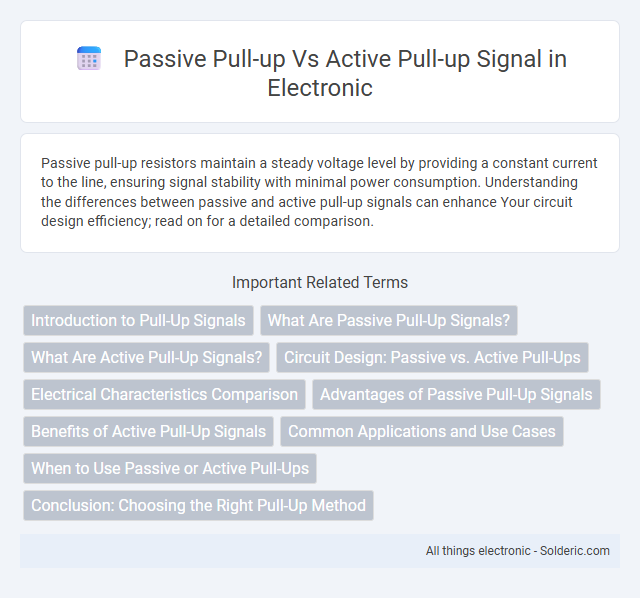Passive pull-up resistors maintain a steady voltage level by providing a constant current to the line, ensuring signal stability with minimal power consumption. Understanding the differences between passive and active pull-up signals can enhance Your circuit design efficiency; read on for a detailed comparison.
Comparison Table
| Feature | Passive Pull-Up | Active Pull-Up |
|---|---|---|
| Definition | Resistor connected to a voltage source providing weak pull-up | Transistor or MOSFET actively pulling the line up |
| Speed | Slower rise time due to resistor | Faster rise time because of direct drive |
| Power Consumption | Constant power draw through resistor | Lower power consumption, active only when switching |
| Complexity | Simple and cost-effective | Requires additional components and control logic |
| Signal Integrity | Susceptible to noise, weaker signal strength | Improved signal integrity with stronger drive |
| Applications | I2C, open-drain bus lines for slow signals | High-speed data lines, systems requiring fast response |
Introduction to Pull-Up Signals
Pull-up signals maintain a defined voltage level to prevent floating inputs in digital circuits, crucial for ensuring reliable logic states. Passive pull-ups rely on resistors connected to the power supply, providing a constant weak current to stabilize the signal line. Active pull-ups use transistors or dedicated ICs to drive the line more efficiently, offering faster response times and lower power consumption in complex electronic designs.
What Are Passive Pull-Up Signals?
Passive pull-up signals use resistors connected to a voltage source to maintain a line at a high logic level when no active device is driving it low. These signals rely on the resistor value to limit current flow, ensuring the line is pulled up gently without causing excessive power dissipation or interference. Passive pull-up resistors are common in communication protocols like I2C, where multiple devices share a bus and need a defined default high state.
What Are Active Pull-Up Signals?
Active pull-up signals use an integrated transistor to drive the line voltage high, ensuring faster signal transitions and improved noise immunity compared to passive pull-up resistors. These signals are commonly found in open-drain or open-collector bus systems like I2C, where precise timing and strong drive capability are essential. Your system benefits from faster data communication and reduced power consumption by employing active pull-up technology.
Circuit Design: Passive vs. Active Pull-Ups
In circuit design, passive pull-ups use a resistor connected to a voltage source to maintain a default logic level, providing a simple and low-power solution but slower signal transitions due to RC delay. Active pull-ups utilize a transistor or buffer to drive the line, offering faster switching speeds and stronger current sourcing capabilities, ideal for high-speed or noise-sensitive applications. Your choice depends on required signal integrity, speed, and power consumption constraints in the specific electronic design.
Electrical Characteristics Comparison
Passive pull-up resistors consume constant current regardless of signal state, leading to higher power dissipation, whereas active pull-ups dynamically source current, improving energy efficiency. Passive pull-ups exhibit slower rise times due to resistor-capacitor charging, while active pull-ups provide faster signal transitions through controlled current sourcing. Voltage levels in passive pull-ups rely on resistor sizing, often causing voltage drop under load, whereas active pull-ups maintain stable voltage levels by actively driving the line to the desired logic high.
Advantages of Passive Pull-Up Signals
Passive pull-up signals reduce power consumption by using simple resistors instead of active components, making them ideal for low-power applications. They provide reliable and stable voltage levels with minimal noise interference, enhancing signal integrity in mixed-signal environments. Your designs benefit from cost-effective implementation and improved electromagnetic compatibility by employing passive pull-up resistors.
Benefits of Active Pull-Up Signals
Active pull-up signals provide faster and more reliable signal transitions by actively driving the line high with a dedicated transistor rather than relying on a resistor and external voltage level. This results in improved signal integrity and reduced power consumption, especially in high-speed communication protocols like I2C or USB. Enhanced noise immunity and reduced signal delay contribute to overall system stability and performance.
Common Applications and Use Cases
Passive pull-up signals are commonly used in open-drain or open-collector circuits, such as I2C communication buses, where devices share a common line and require a default high voltage level. Active pull-up signals are typical in microcontroller input circuits and sensor interfaces, providing faster response times and more reliable switching by sourcing current directly. Applications involving digital logic level translation and bus arbitration often prefer active pull-ups to ensure signal integrity under varying load conditions.
When to Use Passive or Active Pull-Ups
Passive pull-ups are suited for low-speed digital circuits where minimizing power consumption and circuit simplicity are priorities, commonly implemented with resistors connecting the line to a positive voltage. Active pull-ups, using transistors or integrated buffer circuits, provide faster signal rise times and stronger drive capability, making them ideal for high-speed or noisy environments requiring reliable logic level transitions. Choosing between passive and active pull-ups depends on the trade-off between speed requirements and power efficiency in specific applications like microcontroller input lines or I2C bus communication.
Conclusion: Choosing the Right Pull-Up Method
Choosing the right pull-up method depends on your circuit's power consumption, speed requirements, and signal integrity needs. Passive pull-ups are simpler and consume less power, making them ideal for low-speed or battery-powered applications. Your decision should weigh the trade-offs between the stable, slower response of passive pull-ups and the faster, more controlled signal levels provided by active pull-ups.
passive pull-up vs active pull-up signal Infographic

 solderic.com
solderic.com